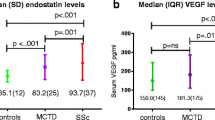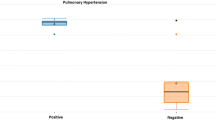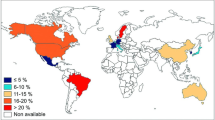Abstract
Systemic sclerosis (SSc) is a rare multisystem chronic disease and its etiology is still unknown. To obtain and generate reasonable treatment methods, new mediators or targets are needed. Urotensin-II (U-II) is predominantly a vasoactive peptide with fibrotic and prothrombotic features. Like endothelin-1 (ET-1), U-II could play an important role in SSc pathogenesis given its properties of convenient one-to-one SSc pathogenetic pathways. A consecutive group of 55 patients diagnosed with SSc and 30 healthy controls were included in the study. Patients and healthy controls were evaluated for clinical and laboratory manifestations, specific organ involvement, autoantibodies, and activity scores specific for SSc. In addition, plasma ET-1 and plasma levels of U-II-like immunoreactivity of both groups were compared. ET-1 level significantly increased in the SSc group in contrast to the healthy controls (6.38 ± 1.39 and 0.99 ± 0.27 pg/ml; p = 0.006). U-II was also significantly elevated in patients, and the plasma levels of U-II-like immunoreactivity were positively correlated with ET-1 (8.19 ± 1.74 and 1.02 ± 0.19 pg/ml; p = 0.003 and p = 0.0001; r = 0.887). For reasonable treatment of SSc, we need to focus on new targets such as ET-1 and U-II. This study hypothesized that these mediators could have a role in SSc pathogenesis, and U-II antagonist might be a potential alternative therapy for these patients.

Similar content being viewed by others
References
Vancheeswaran R, Magoulas T, Efrat G et al (1994) Circulating endothelin-1 levels in systemic sclerosis subsets: a marker of fibrosis or vascular dysfunction? J Rheumatol 21:1838–1844
Abraham DJ, Vancheeswaran R, Dashwood MR et al (1997) Increased levels of endothelin-1 and differential endothelin type A and B receptor expression in scleroderma-associated fibrotic lung disease. Am J Pathol 151:831–841
Rubin LJ, Badesch DB, Brast RJ et al (2002) Bosentan therapy for pulmonary arterial hypertension. N Engl J Med 346:896–903
Denton CP, Humbert M, Rubin L et al (2006) Bosentan treatment for pulmonary arterial hypertension related to connective tissue disease: a subgroup analysis of the pivotal clinical trials and their open-label extensions. Ann Rheum Dis 65:1336–1340
Maguire JJ, Kuc RE, Davenport AP (2000) Orphan-receptor ligand human urotensin II: receptor localization in human tissues and comparison of vasoconstrictor responses with endothelin-1. Br J Pharmacol 131:441–1446
Zhu YC, Zhu YZ, Moore PK (2006) The role of urotensin II in cardiovascular and renal physiology and diseases. Br J Pharmacol 148:884–901
Zhang YM, Liu WJ, Shi YZ et al (2008) Expressions of urotensin II and its receptor in pulmonary arteries in rats with chronic thromboembolic pulmonary hypertension. Zhonghua Jie He He Hu Xi Za Zhi 31:37–41
Richards AM, Nicholls MG, Lainchbury JG et al (2002) Plasma urotensin II in heart failure. Lancet 17(360):545–546
Totsune K, Takahashi K, Arihara Z et al (2003) Increased plasma urotensin II levels in patients with diabetes mellitus. Clin Sci (Lond) 104:1–5
Totsune K, Takahashi K, Arihara Z et al (2001) Role of urotensin II in patients on dialysis. Lancet 8(358):810–811
Masi AT, Medsger TA, Rodnan GP et al (1980) Preliminary criteria for the classification of systemic sclerosis. Arthritis Rheum 23:581–590
Clements P, Lachenbruch P, Seibold J et al (1995) Inter and intraobserver variability of total skin thickness score (modified Rodnan TSS) in systemic sclerosis. J Rheumatol 22:1281–1285
Valentini G, Della Rossa A, Bombardieri S et al (2001) European multicentre study to define disease activity criteria for systemic syclerosis. II. Identification of disease activity variables and development of preliminary activity indexes. Ann Rheum Dis 60:592–598
Medsger TA Jr, Silman AJ, Steen VD et al (1999) A disease severity scale for systemic sclerosis: development and testing. J Rheumatol 26:2159–2167
Silman A, Akesson A, Newman J (1998) Assessment of functional ability in patients with SSc: a proposed new disability assessment instrument. J Rheumatol 25:79–83
Ozer O, Davutoglu V, Ercaan S et al (2009) Plasma urotensin II as a marker for severity of rheumatic valve disease. Tohoku J Exp Med 218:57–62
Pache M, Schwarz HA, Kaiser HJ et al (2002) Elevated plasma endothelin-1 levels and vascular dysregulation in patients with rheumatoid arthritis. Med Sci Monit 8:616–619
Julkunen H, Saijonmaa O, Gronhagen-Riska et al (1991) Raised plasma concentrations of endothelin-1 in systemic lupus erythematosus. Ann Rheum Dis 50:526–527
Yoshio T, Masuyama J, Mimori A et al (1995) Endothelin-1 release from cultured endothelin cells induced by sera from patients with systemic lupus erythematosus. Ann Rheum Dis 54:361–365
Stewart DJ, Levy RD, Cernacek P et al (1991) Increased plasma endothelin-1 in pulmonary hypertension: marker or mediator of disease? Ann Intern Med 114:464–469
Peterlana D, Puccetti A, Caramaschi P et al (2006) Endothelin-1 serum levels correlate with MCP-1 but not with homocysteine plasma concentration in patients with systemic sclerosis. Scand J Rheumatol 35:133–137
Yamane K, Miyauchi T, Suzuki N et al (1992) Significance of plasma endothelin-1 levels in patients with systemic sclerosis. J Rheumatol 19:1566–1571
Shi-Wen X, Chen Y, Denton CP et al (2004) Endothelin-1 promotes myofibroblast induction through the ETA receptor via a rac/phosphoinositide 3-kinase/Akt-dependent pathway and is essential for the enhanced contractile phenotype of fibrotic fibroblasts. Mol Biol Cell 15:2707–2719
Abraham D, Distler O (2007) How does endothelial cell injury start? The role of endothelin in systemic sclerosis. Arthritis Res Ther 9 Suppl 2:S2
Kuryliszyn-Moskal A, Klimiuk PA, Sierakowski S (2005) Soluble adhesion molecules (SVCAM-1, sE-selectin), vascular endothelial growth factor(VEGF) and endothelin-1 in patients with systemic sclerosis: relationship to organ systemic involvement. Clin Rheumatol 24:111–116
Morelli S, Ferri C, Polettini E et al (1995) Plasma endothelin-1 levels, pulmoner hypertension, and lung fibrosis in patients with systemic sclerosis. Am J Med 99:255–260
Yamane K, Kashiwagi H, Suzuki N et al (1991) Elevated plasma levels of endothelin-1 in systemic sclerosis. Arthritis Rheum 34:243–244
Bern HA, Pearson D, Larson BA et al (1985) Neurohormones from fish tails: the caudal neurosecretory system. I. Urophysiology and caudal neurosecretory system in fishes. Recent Prog Horm Res 41:533–552
Douglas SA, Tayara L, Ohlstein EH et al (2002) Congestive heart failure and expression of myocardial urotensin-II. Lancet 359:1990–1997
Lapp H, Boerrigter G, Costello-Boerrigter LC et al (2004) Elevated plasma urotensin-II-like immunoreactivity in ischemic cardiomyopathy. Int J Cardiol 94:93–97
Joyal D, Huynh T, Aiyar N et al (2006) Urotensin II levels in acute coronary syndromes. Int J Cardiol 108:31–35
Lim M, Honisett S, Sparkes CD, Komesaroff P, Kompa A, Krum H et al (2004) Differential effect of urotensin II on vascular tone in normal subjects and patients with chronic heart failure. Circulation 109:1212–1214
Sondermeijer B, Kompa A, Komesaroff P et al (2005) Effect of exogenous urotensin-II on vascular tone in skin microcirculation of patients with essential hypertension. Am J Hypertens 18:1195–1199
Kompa AR, Thomas WG, See F et al (2004) Cardiovascular role of urotensin II: effect of chronic infusion in the rat. Peptides 25:1783–1788
Tran L, Kompa AR, Kemp PA et al (2010) Chronic urotensin-II infusion induces diastolic dysfunction and enhances collagen production in rats. Am J PAHysiol Heart Circ PAHysiol 298:608–613
Qi J, Du J, Tang X et al (2004) The upregulation of endothelial nitric oxide synthase and urotensin-II is associated with pulmonary hypertension and vascular diseases in rats produced by aortocaval shunting. Heart Vessels 19:81–88
Djordjevic T, Görlach A (2007) Urotensin-II in the lung: A matter for vascular remodelling and pulmonary hypertension? Thromb Haemost 98:952–962
Djordjevic T, BelAiba RS, Bonello S et al (2005) Human urotensin II is a novel activator of NADPH oxidase in human pulmonary artery smooth muscle cells. Arterioscler Thromb Vasc Biol 25:519–525
Zhang Y, Li J, Cao J et al (2002) Effect of chronic hypoxia on contents of urotensin II and its functional receptors in rat myocardium. Heart Vessels 16:64–68
Cheung BM, Leung R, Man Y et al (2004) Plazma concentration of urotensin II is raised in hypertension. J Hypertens 22:1341–1344
Khan SQ, Bhandari SS, Quinn P et al (2007) Urotensin II is raised in acute myocardial infarction and low levels predict risk of adverse clinical outcome in humans. Int J Cardiol 117:323–328
Disclosures
None.
Author information
Authors and Affiliations
Corresponding author
Rights and permissions
About this article
Cite this article
Pehlivan, Y., Onat, A.M., Comez, G. et al. Urotensin-II in systemic sclerosis: a new peptide in pathogenesis. Clin Rheumatol 30, 837–842 (2011). https://doi.org/10.1007/s10067-011-1688-3
Received:
Revised:
Accepted:
Published:
Issue Date:
DOI: https://doi.org/10.1007/s10067-011-1688-3




